Particle Board Subfloor - Too Many Negatives
Author: Omar Alonso | Editor: Omar Alonso
Review & Research: Jen Worst & Chris Miller
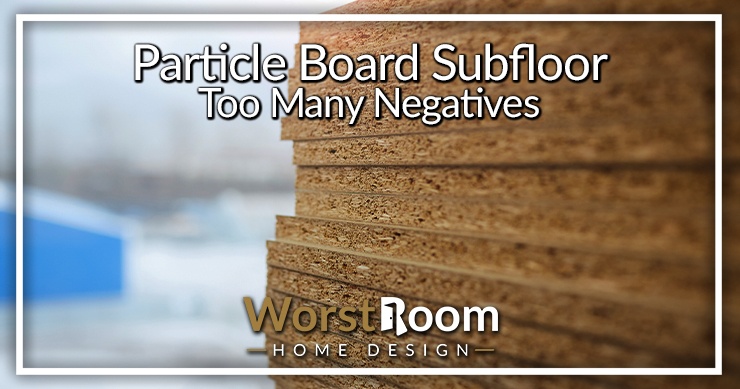
Are you planning on installing new flooring? The project is a great way to spruce up your home and its appeal to guests or buyers. Whether you're installing hardwood vinyl boards, tiles, or a new carpet, proper subfloor preparation is key to success with the task. You may be considering a particle board subfloor.
When installing a new subfloor, many homeowners opt for particleboard for the surface. Particle board seems like it has plenty of advantages for the underlayment. Unfortunately, the cons exceed the pros in this case, and you'll want to consider another material for the subfloor.
Particle Board Explained
Let's unpack the manufacturing process for particle board to give you a better understanding of this material. Particle board comes in 4’×8’ panels featuring construction with dried wood particles dusted or sprayed with a binder resin and bonded under heat and pressure.
Manufacturers use all different types of wood for the board. They can feature shavings, trimmings, or sawdust collected from mills manufacturing wood products or plywood boards. Particle board also goes by the names chipboard, strand board, wafer board, or flake board.
Due to its construction with small wood particles, the panels come with a flat, smooth surface featuring a soft texture that easily flakes into pieces and doesn't have much strength to it. It's common for particle boards to feature in furniture construction for countertops and shelving, usually finished with a laminate or veneer surface.
Particle board isn't a great choice for subfloors because of its lack of strength and tendency to flake. In other cases it can act as a plywood alternative, but in this case it does not.
Underlayment vs. Subfloor – Definitions & Uses
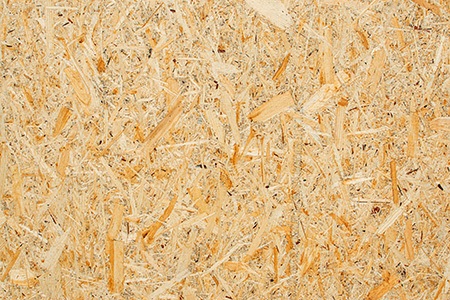
A common error many DIY homeowners make is confusing the underlayment and subflooring flooring projects. Both are vital components of flooring systems but with distinct differences. The subfloor provides structural integrity to the flooring system and is the thick wooden layer screwed into floor joists.
The subfloor must be made from strong, durable material capable of handling heavy loads. Most contractors use oriented-strand board (OSB) or plywood sheets when constructing subfloors. While some finished flooring materials suit the direct application to the subfloor, many contractors recommend homeowners spring for the addition of underlayment between the finished floor and subfloor.
Using an underlayment stiffens the floor, creating a level, smooth backing for the finished floor while adding strength to the flooring system. Depending on the finished flooring system used in the project, the underlayment can feature construction with various materials, and particle board is an option.
Since particle board is non-structural, it doesn't have approval in building codes for use as suitable subflooring material. It doesn't offer the strength required to meet safety standards and can lead to premature failure of the subfloor.
Reasons To Use Particle Board for Underlayment
One of the biggest reasons many homeowners choose to go with particle board for subflooring is the cost. It's a cheap material, and it's understandable how the cost savings seem attractive to flooring projects. After all, if you save on the subfloor, you can add more budget to getting a hardwood or tiled flooring system over vinyl boards or carpets.
The average cost of a 4'x8' particle board is around $10 per sheet, while common types of plywood costs around $35 for the same size sheet. That's a massive saving if we consider the size of the average flooring project. Another advantage of particle board is its smooth, flat surface.
Particle board underlayment on top of subflooring materials creates a solid, thick base useful for vinyl, linoleum, or carpets. Another advantage of particle board is its ability to raise the height of the floor for transitions between materials.
Reasons To Avoid Using Particle Board for Underlayment
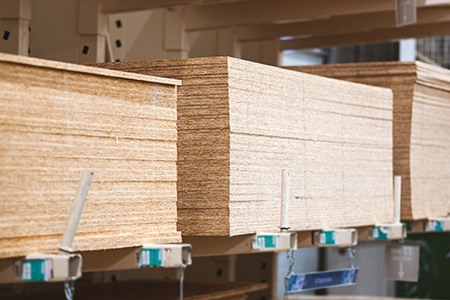
While the pros seem appealing, there are far more cons to using particle board as subflooring. It's a smooth, inexpensive material, but that's not enough to consider it for the subfloor.
Moisture Problems
One of the biggest issues with a particle board subfloor is that it tends to fall to pieces with the slightest exposure to moisture. Since most particle board is simply sawdust bonded together using resin, heat, and pressure, it readily absorbs moisture and starts to swell and crack.
Both the resin and the materials used to make the particle board absorb moisture, creating a double-whammy of adverse effects when exposed to water and other moisture sources. Just the act of gluing the boards to the floor might create enough moisture to see the particle board degrade and lose its structural integrity.
So, when it comes to the uses of particle board in the home, particle board is a bad option for anywhere where it has the potential for exposure to moisture or water damage. Rooms like the kitchen, laundry, or bathroom would be terrible spaces for particle board.
These rooms require fitment with durable, water-resistant flooring systems and subfloors. If water leaks through the flooring and reaches the underlayment, the moisture shouldn't damage the underlayment materials.
It's even a bad idea to use particle board under carpets. If a pet pees on the carpet or someone drops a drink on the floor, that's enough moisture to degrade the particle board. As a result, degraded, swollen particle board becomes a haven for mold spores, and they start to spread, creating a health hazard in the home.
Installation Issues
Since particle board disintegrates easily, installing it with nails is a challenge. Driving a nail close to the edge of the particle board causes it to splinter away, taking a chunk out of the board. Staples, ring-grooved nails, or screws provide better results.
Remember, adhesives like polyvinyl acetate floor underlayment glue or hard-setting casein glue can cause moisture damage on the boards. If you attempt to secure finished flooring to the particle board, laminate flooring, or foam pads, the particle board could sustain damage.
It might fail to adhere properly or create flex and movement in some subfloor areas, pulling it away from the particle board. The particle board is also a pain to remove. If you need to remove the underlayment, you'll find the particle board just breaks away, especially if it's glued or nailed down.
The particle board also falls to pieces as you try to work with it. You'll need tools like drills, chisels, and crowbars to remove the panels and plenty of effort and time to finish the job. Your effort and frustration will likely end up damaging the subflooring as well.
The Best Underlay for Flooring Systems
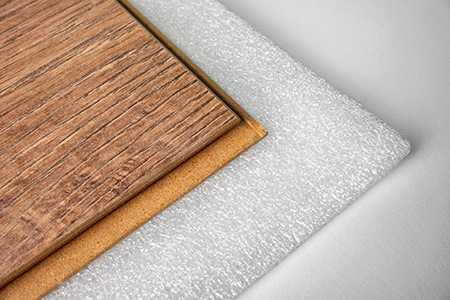
So, we can firmly agree that particle board is not the solution you need for your subfloor or underlayment. The underlayment for your flooring system is a vital component and a must-have element of the flooring system for the best results with your project.
The underlayment is especially crucial for flooring systems like vinyl, as every irregularity in the subfloor will poke through and look atrocious. It's important to include an underlayment for the following reasons:
- It provides resistance to compression of the flooring system
- It absorbs sound
- It absorbs some of the impact of walking on the floor
- It levels the surface
- It hides imperfections and smooths the subfloor
- It provides insulation between the subfloor and the finished surface
Plywood or OSB underlayments are the best choices in all situations, regardless of the room or the finished flooring surface used in the project. Plywood underlayment comes in sheets ¼" thick and 4' wide by 8' long. Almost all flooring manufacturers recommend plywood as the preferred floor underlayment material.
FAQs Regarding a Particle Board Subfloor
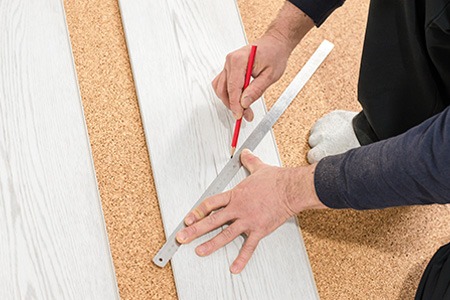
As we’ve been talking about a particle board floor, a lot of other questions have likely been arising in your mind. Let’s cover the most common that we run into now.
Is There a Better Subfloor Material Than Particle Board?
Yes. You can use plywood or OSB for subfloor or underlayment as a better choice than a particle board underlayment. These materials might be two or three times the cost, but they last longer, are durable, and are easier to work with.
What Is the Purpose of a Particle Board Subfloor?
The subfloor provides a stable surface for the flooring system and carries the load of people walking on the floor. Since particle board has little structural integrity, its prone to cracking and breaking. Particle board flooring is a bad idea.
Are Particle Boards a Health Hazard?
Particle boards are not a health hazard in their manufactured format. However, if you install them in underlayment or subflooring applications, they can be exposed to moisture. When wet, the particle board swells and disintegrates.
The particles may come loose and get into the air, or mold may start to grow in the air pockets created as the wood swells. Materials used in manufacturing particle boards can cause respiratory problems like asthma and bronchitis if inhaled.
Key Takeaways for a Particle Board Subfloor
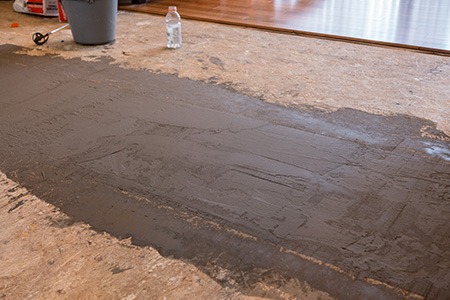
- Particle board is a terrible choice for a material in flooring systems.
- Particle boards should be avoided at all costs, whether as the subfloor or the underlayment.
- Many homeowners choose particle board because it's cheap and wonder why their flooring system falls apart.
- Particle board retails for around $10 a board, while plywood costs around $35 aboard.
- Particle board can't endure contact with any moisture, or it swells and disintegrates.
- Particle board has no structural strength, resulting in a weak subfloor or underlayment prone to collapse.
- Particle board is challenging to work with and breaks away readily when nailing.
A Particle Board Subfloor is a Bad Idea
As we’ve mentioned, a particle board subfloor has way too many negatives to consider using it as an underlayment. You should opt for OSB. Plywood would be even more suitable due to it’s moisture resistance and higher strengths.



